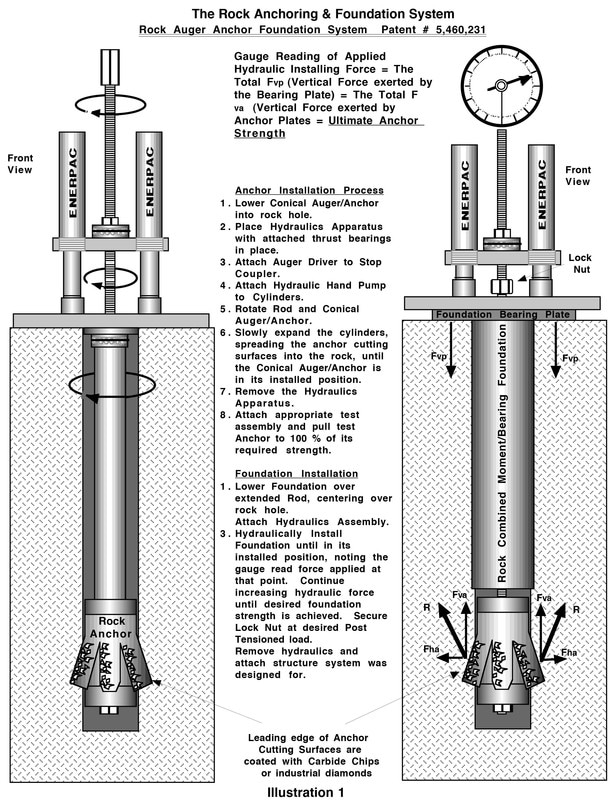Discover the very best Williams Anchors for Protecting Structures and Maintaining Wall Surfaces
Discover the very best Williams Anchors for Protecting Structures and Maintaining Wall Surfaces
Blog Article
Reliable Rock Anchors for Secure and Secure Structures
In the world of civil engineering, the duty of trustworthy rock anchors can not be overstated, as they are critical in establishing safe and secure structures throughout a range of applications. Recognizing the different kinds of rock anchors, their particular applications, and the complexities of installation and maintenance is necessary for enhancing their efficiency.
Kinds Of Rock Anchors

Passive anchors count on the weight of the framework and the surrounding soil or rock to supply resistance. They are commonly used in applications where very little activity is anticipated. Energetic supports, on the various other hand, include the application of tension via a high-strength wire or pole, developing a pre-stressed problem in the support. This kind is especially helpful in vibrant settings, such as landslide-prone locations.
Grouted anchors are another considerable classification, where a steel bar or cable television is inserted right into a drilled opening, followed by a cementitious grout. Once treated, the grout bonds with the bordering rock, creating a robust anchoring system. Each sort of rock anchor offers distinct advantages based on the specific geological conditions and structural needs, therefore playing a critical function in the overall honesty and long life of created facilities.
Applications in Construction
Rock supports play a pivotal function in different construction applications, offering necessary support and stability in diverse environments. These cutting-edge solutions are utilized in tasks varying from large-scale framework advancements to smaller sized property structures. Among the main applications of rock anchors remains in the stabilization of inclines and maintaining walls, where they assist protect against dirt disintegration and maintain structural integrity.
Furthermore, rock supports are important in safeguarding structures for bridges, passages, and skyscrapers, guaranteeing they can endure side forces such as wind and seismic task. Their adaptability permits installment in difficult geological problems, making them ideal for tasks in mountainous or rocky terrains.

Key Choice Requirements
Choosing the suitable rock support for a particular application requires mindful consideration of a number of vital criteria. Firstly, the geological conditions of the website need to be thoroughly examined. Understanding rock kind, toughness, and security is important to guarantee that the support will execute efficiently under lots conditions.

Another crucial aspect is the deterioration resistance of the anchor materials. In environments subjected you could try here to moisture or chemicals, making use of corrosion-resistant materials will lengthen the life expectancy of the supports and preserve architectural honesty in time.
Furthermore, the anchor's installment technique should line up with the task's needs and restraints. Reduce of installation, as well as the potential influence on bordering frameworks, must be try this taken into consideration.
Installation Methods
Reliable setup methods are critical for the effective performance of rock supports. Appropriate setup ensures that the anchors attain the wanted load-bearing capability and stability within the geological problems. The primary step in the setup process includes website analysis, where geological studies identify the rock type, condition, and any kind of prospective difficulties.
When the website is examined, the suitable exploration approach should be picked-- options consist of rotating drilling, diamond drilling, or percussion drilling. The choice depends upon rock firmness and environmental considerations. Accurate exploration deepness and angle are vital to ensure that the anchors straighten with architectural requirements and tons circulation.
After exploration, the next stage entails cleaning up the borehole to remove debris, which can endanger bond strength. Following this, the support is put, and if needed, a cement or material is injected to improve adhesion. The healing time of these materials need to be adhered to, ensuring that the supports accomplish complete strength prior to any resource load is used.
Maintenance and Inspection
Proper maintenance and evaluation of rock anchors are necessary to ensure their lasting performance and integrity (Williams Anchors). Regular assessments aid determine any potential problems, such as corrosion, variation, or structural exhaustion that might jeopardize the stability of the anchoring system
Routine inspections should be carried out at specified periods, considering environmental factors and the certain application of the rock supports. Visual assessments ought to concentrate on the revealed sections of the supports, checking for indications of corrosion, fractures, or various other abnormalities. Additionally, it is important to review the bordering geological conditions to discover any type of changes in dirt or rock that might affect anchor performance.
Sometimes, even more sophisticated strategies such as lots screening or non-destructive screening might be necessitated to ascertain the anchors' load-bearing capacity and overall health. Proper documentation of evaluation findings, maintenance activities, and any repair work or replacements performed is vital for ongoing evaluation and compliance with sector criteria.
Verdict
In verdict, trusted rock supports play a critical duty in making certain safe and secure and secure foundations across various building and construction applications. By properly moving lots and improving stability against side forces, these anchors add dramatically to the durability and integrity of structures such as bridges, passages, and keeping walls. Strategic option, setup, and maintenance of rock supports are necessary for enhancing performance and guarding public security, ultimately emphasizing their significance in modern design practices.
Report this page